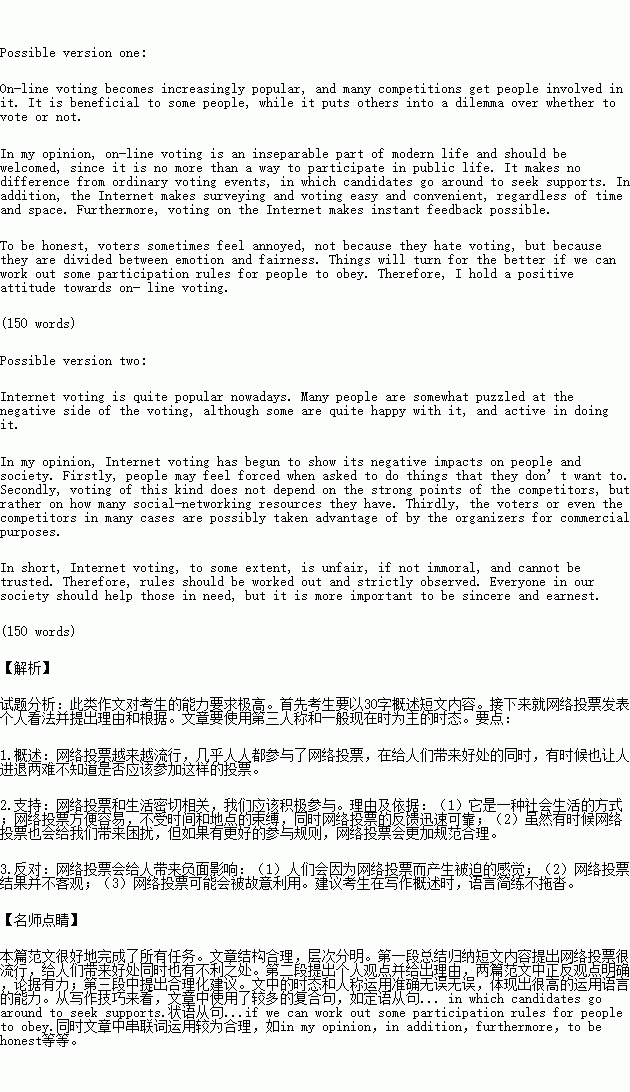题目内容
书面表达
请阅读下面短文,并按照要求用英语写一篇150词左右的文章。
In recent years, internet voting has become increasingly popular in China. People not only cast on-line votes themselves, but also urge others to vote for competitions like the "Most Beautiful Teacher" and the " Cutest Baby".
Li Jiang, a high school student, is invited to vote in the " Best Police Officer" competition, organized by the local government to let the public have a better understanding of police officers’ daily work. Li Jiang visits the website and reads all the stories. He is deeply moved by their glorious deeds. He is already thinking of becoming a policeman himself in the future.
Su Hua is invited by his uncle to vote for his cousin in the " Future Singer" competition. He has already received three similar invitations this week. His uncle tells him that if his cousin wins the competition, the family will win an overseas tour for free. Su Hua likes his cousin very much, but he finds other singers perform even better. To vote, or not to vote? This is a question that troubles him very much.
【写作内容】
1. 用约30个单词写出上文概要;
2. 用约120个单词阐述你对网络投票的看法,并用2~3个理由或论据支撑你的看法。
【写作要求】
1. 写作过程中不能直接引用原文语句;
2. 作文中不能出现真实姓名和学校名称;
3. 不必写标题。
【评分标准】
内容完整,语言规范,语篇连贯,词数适当。
书面表达
假设你班最近举行了一次班会,讨论怎样把英语学习变成一件快乐的事。请你根据下表所提示的信息,为某英语周报网站写一篇短文,谈谈你们的讨论情况并提出你的建议。
讨论情况 | 1. 课内互动 |
2. 课外活动(演讲或晚会等) | |
3. 运用英语(口头或书面交流) | |
…… | |
你的建议 | …… |
注意:
1. 对所给要点注意陈述,不要简单翻译。
2. 词数110左右。开头已经写好,不计入总词数。
参考词汇:interactive 互动的
Recently, we had a discussion on how to make learning English relaxing and fun. ____________________________________________________________________________________________
____________________________________________________________________________________________
____________________________________________________________________________________________
____________________________________________________________________________________________
____________________________________________________________________________________________
____________________________________________________________________________________________
阅读理解
请阅读下列短文,从短文后各题所给的A、B、C、D四个选项中,选出最佳选项,并在答题卡上将该项涂黑。
|
Day school Program Secondary students across Toronto District School Board(TDSB) are invited to take one or two e-Learning courses on their day school timetable. Students will remain on the roll at their day school. The on-line classroom provides an innovative, relevant and interactive learning environment. The courses and on-line classroom are provided by the Ministry of Education. These on-line courses Benefits of e-Learning Include: Is e-Learning for You? Students who are successful in an on-line course are usually: Students need to spend at least as much time with their on-line course work as they would in a face-to-face classroom course. |
1.E-Learning courses are different from other TDSB courses in that _________.
A. they are given by best TDSB teachers
B. they are not on the day school timetable
C. they are not included on students’ reports
D. they are an addition to TDSB courses
2.What do students need to do before completing e-Learning courses?
A. To learn information technology on-line.
B. To do their assignments independently.
C. To update their mobile devices regularly.
D. To talk face to face with their teachers.



 are taught by TDSB secondary school teachers;
are taught by TDSB secondary school teachers;